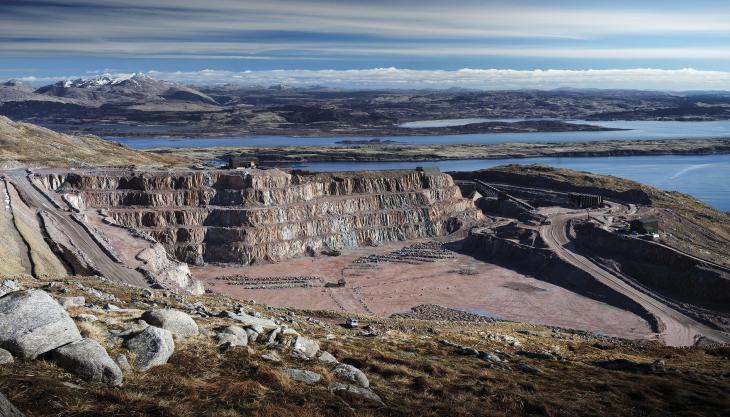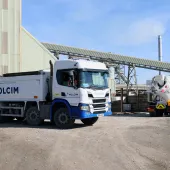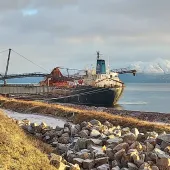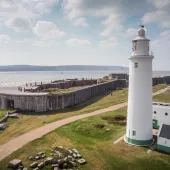Glensanda marks 30 years of shipping

Scottish west coast super quarry celebrates 30th anniversary of first shipment of granite
TODAY marks the 30th anniversary of the first shipment made from the Glensanda super quarry on the west coast of Scotland. Located on the Morvern Peninsula, near Oban, Glensanda is Aggregate Industries’ flagship site and the largest granite quarry in Europe, exporting to markets all across Northern Europe. It has an annual production capacity in excess of 9 million tonnes and some 760 million tonnes of granite reserves.
Glensanda was first discovered by John Yeoman while on a boating holiday in the 1970s. The site was then named as a potential location for a super quarry in a report commissioned by the Government in the 1970s. Extraction began in 1986 and Glensanda undertook its first shipment on 5 August that year, to Houston, Texas.
Since then more than 5,500 shipments have been made to projects throughout Europe including: the Channel Tunnel; the TGV rail line from Bordeaux to Bayonne and the Pont de Normandie in France; Deurganckdok in Antwerp; Schipol airport in Amsterdam; Moorburg power station in Hamburg; the A1 motorway from Gdansk to Torun; Riga airport; and the Olympic Park for the London 2012 Olympic Games and the new London Gateway container port.
Located on the shores of Loch Linnhe and only accessible by sea, Glensanda is renowned for being one of the most efficient mineral extraction operations in the world. The granite is crushed at the top of the mountain before being fed into a 300m deep ‘glory hole’ and exiting the mountain through a 1.8km horizontal tunnel to the foreshore where the rock is washed, screened and stored ready for ship loading.
The site is one of the UK’s top 10 tonnage ports and has its own fleet of purpose-built ships, including the Yeoman Bontrup and Yeoman Bridge – the largest gravity-fed, self-discharging bulk carriers in the world, capable of transporting almost 100,000 tonnes of high-quality granite on each shipment. It has the capability to transport products directly from its dedicated harbour to customers in deep-water ports around the UK and Northern Europe where granite is in short supply.
Not only is Glensanda one of Europe’s largest resources of consistently high-quality, durable granite, it is also one of the largest single quarry operations in the world, employing 120 direct workers and supporting a further 300 third party jobs.
Philippe Frenay, managing director – UK and overseas at Aggregate Industries, said: ‘From the first shipment in 1986, Glensanda has come a long way over the last 30 years to become one of the most valuable exporting businesses in Scotland, accounting for close to 100% of all aggregate exported from Britain.
‘We have continued to invest in the site over the years to get it to where it is today, including a £30 million investment in a new crusher and delivery system in 2014. Despite this investment, it’s the 200-plus men and women on site, the vessel crews and our distribution network personnel that keep the operation running, and I’d like to thank them for their hard work and say: ‘here’s to the next 30 years’.’
Key milestones:
- 1970s: Glensanda first spotted by John Yeoman and named as a potential location in a report commissioned by the Government in the 1970s to identify coastal super quarries
- 1986: Quarry extracts and processes first cargo for export
- 5 August 1986: First vessel, Hellesport Monarch, loaded from Glensanda
- 10 days later: First market supplied – Houston, Texas – cargo 53,879 tonnes
- 1986–1988: First shipments made to the Caribbean, Germany, Holland and Denmark
- 1989: Glensanda concreting aggregates delivered to the Falkland Islands in ‘big bags’ – the furthest market Glensanda has delivered to
- 1991: Yeoman Bank (36,000 tonnes), Yeoman Burn and Yeoman Brook (77,000 tonnes) arrive as dedicated shuttle vessels
- 1991–1992: First shipments to Belgium, Poland and France
- 1997: Capacity at Glensanda extended via installation of a washing and screening plant
- March 1997: First shipment to Spain
- June 2000: Yeoman Bridge (97,000 tonnes) enters service
- June 2002: First shipment to Africa (Equatorial Guinea)
- September 2002: Yeoman Bontrup (97,000 tonnes) enters service
- 2007: More than 7 million tonnes shipped in one year
- September 2008: First shipment to Ireland
- 2009–2011: Glensanda stone delivered to Isle of Grain and then shipped by barge to Olympic Park for London 2012 Olympic Games
- 14 February 2013: Yeoman Bridge delivers the first 85,000-tonne cargo to the London Gateway project. The largest vessel of its size and draft to navigate the Thames so close to London
- June 2013: First shipment to Latvia
- 2014: £30 million investment in a new crusher and delivery system at Glensanda Quarry
- January 2016: New terminal opened at Port of Tyne
- 5 August 2016: 30th anniversary of first shipment from Glensanda
- To date: More than 5,500 ships loaded to more than 100 separate markets
- By end September 2016: 150 million tonnes will have been shipped from Glensanda.









